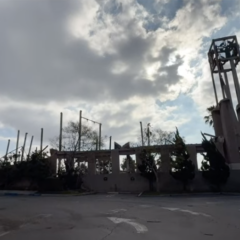Black leaders and residents of Los Angeles are dealing with stress and trauma after the racially motivated terrorist attack at a grocery story in Buffalo, New York. A self-described white supremacist killed 10 and wounded three others. The Los Angeles Times spoke with the Rev. Dr. Najuma Smith-Pollard, along with Cecil Murray Center alum the Rev. Stephen “Cue” Jn-Marie.
Faith and city leaders also gathered at First AME Church of Los Angeles to mourn those killed in Buffalo, as well as at a church shooting in Laguna Woods in Orange County (pictured, CRCC’s Smith-Pollard holds the mic next to Mayor Eric Garcetti). The Los Angeles Sentinel and Pasadena Star-News covered the event.
Read an excerpt from the L.A. Times‘ article:
The Rev. Najuma Smith-Pollard, assistant director of community and public engagement at USC’s Center for Religion and Civic Culture, said incidents like the Buffalo shooting often are trauma triggers and hit home for people who have lost loved ones in gun violence.
“Even though we understand this particular incident, or this incident in Buffalo where the perpetrator was a white supremacist, having a loved one’s life snatched like that from a shooting, it hits home for anyone who’s had that happen to them,” Smith-Pollard said. “You’re going to be triggered by it even if you don’t want to be because you know what it’s like to experience that kind of loss.”
She said Black residents and leaders in Los Angeles and nationwide are looking at Buffalo as another case study for why they have to keep fighting and that “we’re not crazy, that this country is at its core racist and full of white supremacy and it hasn’t gone away.”
She pointed out that part of the work being done includes incorporating talking about how to address trauma around violence and white supremacy as part of social justice work and activism.
“It’s the re-traumatizing of the lie that you keep telling us racism doesn’t exist, and that we’re crazy,” Pollard-Smith said. “It’s multi-layered trauma, and conversations, and things that need to be continued to be addressed and then at the other side of it is like this feeling of when does it stop?”
Click here to read the full story.




